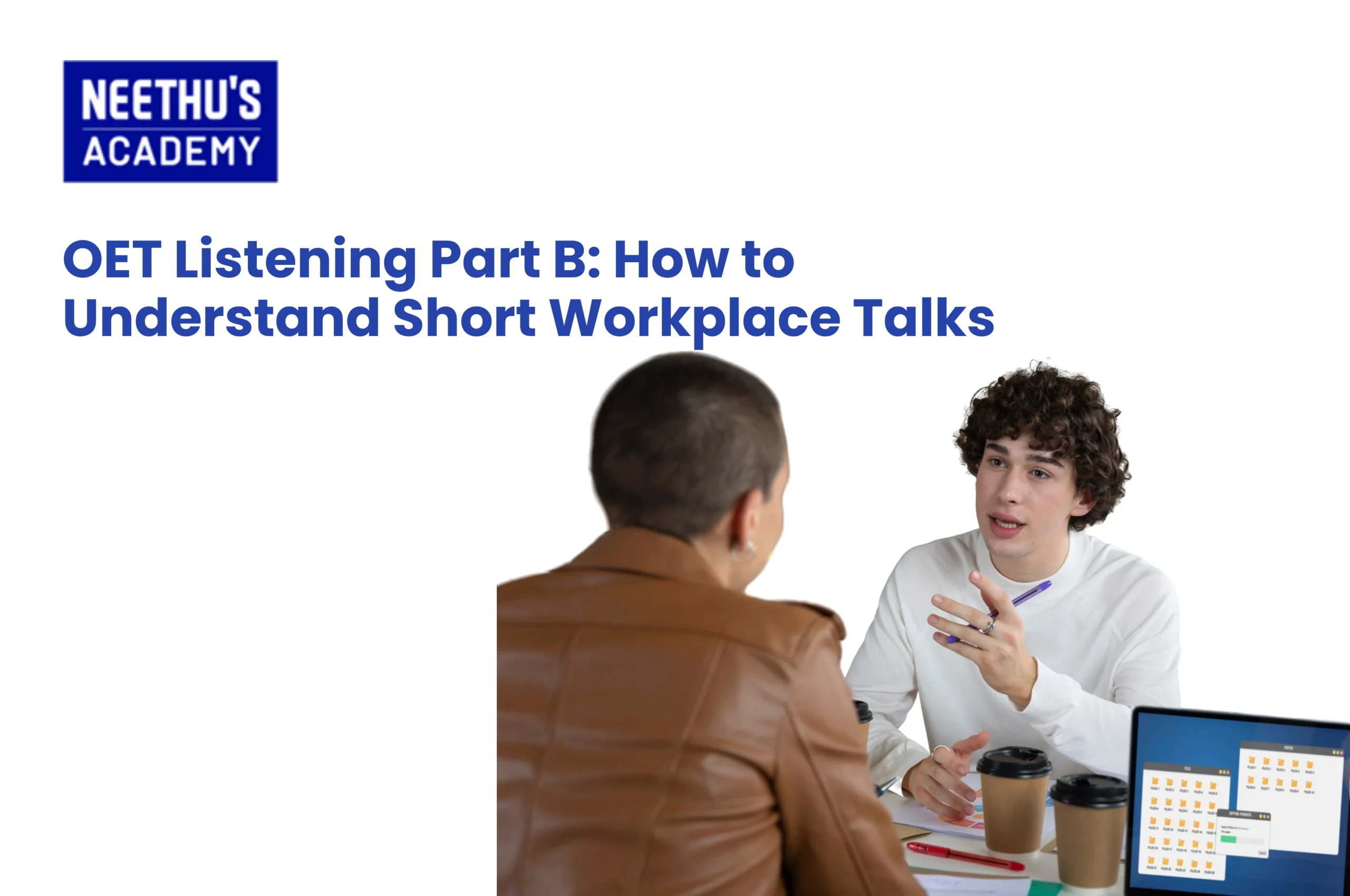The Occupational English Test, otherwise known as OET, is a professional test on language proficiency for healthcare professionals. Becoming great at reading…

OET Listening Part B: How to Understand Short Workplace Talks
OET Listening Part B is a vital part of the Occupational English Test (OET) that assesses your capacity to understand short workplace recordings — the type of brief conversations, directions, or discussions that healthcare workers have every day. This part is important because it mirrors real-world communication situations like handovers, staff meetings, or interactions with coworkers, to ensure that healthcare professionals can work effectively in English-speaking settings. Scoring high in this section shows your ability to listen correctly, understand meaning, and answer accordingly within a workplace context.
OET Listening Part B Structure
OET Listening Part B has six short recordings, each around one minute. Each recording is followed by one multiple-choice question with three options (A, B, or C). The recordings are real workplace scenarios in healthcare, e.g.:
- Communication among health workers (nurses, physicians, or allied personnel)
- In a medical institution, announcements or briefings
- Pre-recorded messages, instructions, or patient handovers
This part is the broader OET Listening sub-test, consisting of Parts A, B, and C, and lasting approximately 40 minutes. While Part A (patient consultations) and Part C (lengthier academic discussions) measure your ability to understand longer, more prepared-for conversation, Part B assesses your ability to understand short, spontaneous, and functional communication in workplaces.
Types of Audio Clips Used
The audio recordings in OET Listening Part B aim to mimic actual healthcare communication. Knowing the various formats enables you to predict what to listen for:
- Instructions or Guidelines – e.g., instructions by a senior nurse to the team on a new procedure.
- Workplace Conversations – e.g., a dialogue between a nurse and a doctor on patient management.
- Announcements or Updates – e.g., a brief safety or policy update by a manager.
- Phone Messages or Briefings – e.g., a message about shift change or patient transfer.
- Handovers or Reports – e.g., a brief summary of a patient’s status or medication orders.
- Policy or Ethical Discussions – e.g., brief conversations regarding professional standards or workplace conduct.
The audios feature multiple accents—British, Australian, New Zealand, North American, and sometimes Irish or South African—to mimic the diversity of international healthcare settings.
Techniques to Catch Key Ideas and Tone
Active and attentive listening is needed to understand short audios quickly. Below are professional OET listening tips to help you excel in Part B:
- Predict Before Listening
Prior to the audio, read carefully the question and options. Try to anticipate what the context may be — either that it’s an instruction, complaint, or announcement. This internal preparation enables you to attune your attention to certain information.
- Listen for the Main Idea
Don’t pay attention to each word; rather, pick up on the gist or main message. Ask yourself: What is the purpose of the speaker? — Are they informing, warning, asking for, or advising?
- Notice the Tone and Attitude
The tone of the speaker usually betrays the right answer. For instance, a polite notice could be delivered in a calm tone, whereas a reprimand can be spoken in a firm or assertive tone. Recognizing emotions and purposes might separate fairly similar options.
- Watch Out for Paraphrasing
The choices are seldom exact word-for-word from the audio. The test sees if you can identify paraphrases and synonyms, as in “check the dosage” being restated as “verify the medication amount.”
- Don’t Pay Attention to Distraction
The test contains distractors—misleading information used to test your attention. The speaker may discuss several ideas, but only one actually answers the question. Be on your guard when they change direction or correct themselves during a sentence.
- Use Elimination Strategically
Eliminate options that are too general, too extreme, or unrelated to the speaker’s purpose if unsure. This increases your chances of guessing correctly.
- Practice Active Note-taking
Since you can’t pause or replay the audio, brief notes or symbols will do. For instance, “+” for agreement, “→” for instruction, or “!” for warnings. These signals enable you to quickly remember the main idea.
Pitfalls in Multiple-Choice Questions
OET Listening Part B questions are subtle in nature, not because the recording is lengthy, but due to the phrasing of options. These are some common traps to be avoided:
- Keyword Distraction – The question contains a word that can be found in the recording, but the meaning does not correspond to the answer. Pay attention to meaning, not the same words.
- Half-True Statements – Certain choices will be largely true but lack the critical point. The best answer always captures the overall purpose, not merely one detail.
- Tone Mismatch – Content may sound the same, but tone betrays the actual intent (e.g., suggestion vs. instruction).
- Speech Rate – Don’t be alarmed if the speaker speaks quickly. Pay attention to content indicators such as “the key point is…” or “you need to ensure…”.
- Last-Minute Correction – Sometimes speakers correct their words (“Actually, that’s no longer needed…”). The correction typically has the right answer.
Sidestepping these pitfalls comes from experience, tolerance, and exposure to varied healthcare communication styles.
Practice Materials for Part B Improvement
Regular, planned practice is necessary in order to enhance your performance in OET Listening Part B. Following are the best resources and techniques:
- OET Official Practice Materials
Begin with OET’s official practice tests, which ideally simulate actual exam situations. These contain good-quality sound with authentic accents and medical settings.
- Healthcare Podcasts and BBC Medical Programs
Listening to real-life healthcare conversations, e.g., BBC Health Check or doctor podcasts, exposes you to professional tone, vocabulary, and natural speech pace.
- YouTube Training Channels
OET Online, E2 Test Prep, or OET Preparation Portal channels provide tutorial listening practice with answer explanation and strategy analysis.
- Transcription Practice
Jot down what you can hear from brief healthcare-related audio clips. Match your notes against the transcript to know what you have missed and how you can enhance understanding.
- Accent Familiarization
Practice your ear by listening to brief medical situations or news clips presented in various English accents. Familiarization with diverse pronunciations will make the actual test simpler.
- Group Study or Mock Tests
Sharing audio interpretations with colleagues or mentors assists you in grasping rationale for right answers and identifying frequent listening errors.
Conclusion
OET Listening Part B is not merely an exam section — it’s a test of real-world skills that guarantees healthcare professionals will be able to respond suitably in high-pressure situations. Know its format, train with real materials, and use efficient listening strategies, and you can guarantee short workplace conversations are decoded accurately. Don’t forget: success lies not in memorization but in the cultivation of active listening behaviors reflective of actual healthcare communication.
Frequently Asked Questions
It is approximately 6 minutes (each extract taking about one minute).
There are six multiple-choice questions, one for each extract.
They are variable, but practice is easy to make them understandable.
No, the audio only plays once, so total concentration is required.
Related Blogs
- All Posts
- OET
Course Enquiry
Latest Posts
- All Posts
- canada
- CBT
- DELF
- DHA
- French
- GENERAL
- German
- Haad
- IELTS
- IQN NEW ZEALAND
- MOH
- NCLEX-RN
- NHRA
- OET
- OSCE
- Pearson Vue
- PROMETRIC
- PTE
- TOEFL
- Back
- NCLEX - NGN
- Back
- OET FOR PHYSIOTHERAPIST
- OET FOR PHARMACIST
- OET FOR DOCTORS



- Completely online; can take from home with computer, internet, and webcam.
- Adaptive test format – questions become harder or easier based on answers.
- Speaking, reading, listening, and writing in short interactive tasks.
- Score range: 10–160, and universities usually require 105–125.
